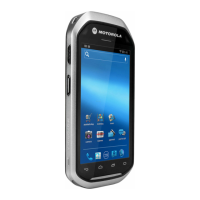Administrator Utilities 6 - 11
The text file contains one line for each group. Each line is formatted as follows:
<groupname>:<user1>,<user2>,…<userN>
where:
<groupname> = the name for a group. This is also the name of the White List file for this group. This
field uses any alphanumeric character.
<user1> through <userN> = the name of the user assigned to this group. The user name is the same
as that defined for the MultiUser feature. See MultiUser Administrator on page 6-6 for more
information.
Examples:
•
AdminGroup:alpha
The Group name is AdminGroup and assigns user alpha to the group.
•
ManagersGroup:beta,gamma
The Group name is ManagerGroup and assigns users beta and gamma to the group.
White List File
A White List file is a text file that provides a list of allowed packages from that group. The text file contains one
line for each allowed package for that user group. Each line is format as follows:
<package1name>
.
.
.
<packageNname>
where:
<package1Name> = is the package name allowed for this group. Wild cards are allowed for this field.
Examples:
Refer to the example of the Groups file above. A White List file of the name AdminGroup could have the
following lines:
com.companyname.application
com.motorolasolutions.*
where:
com.companyname.application = the specific application with the package name
com.companyname.application will be permitted for this group.
com.motorolasolutions.* = any application that has a package name that starts with
com.motorolasolutions will be permitted for this group.
NOTE If the same user is assigned to multiple groups, then that user’s White List will be a logical union of the
White Lists for all of the groups that user is assigned.
A line starting with the # character is considered a comment and is ignored.

